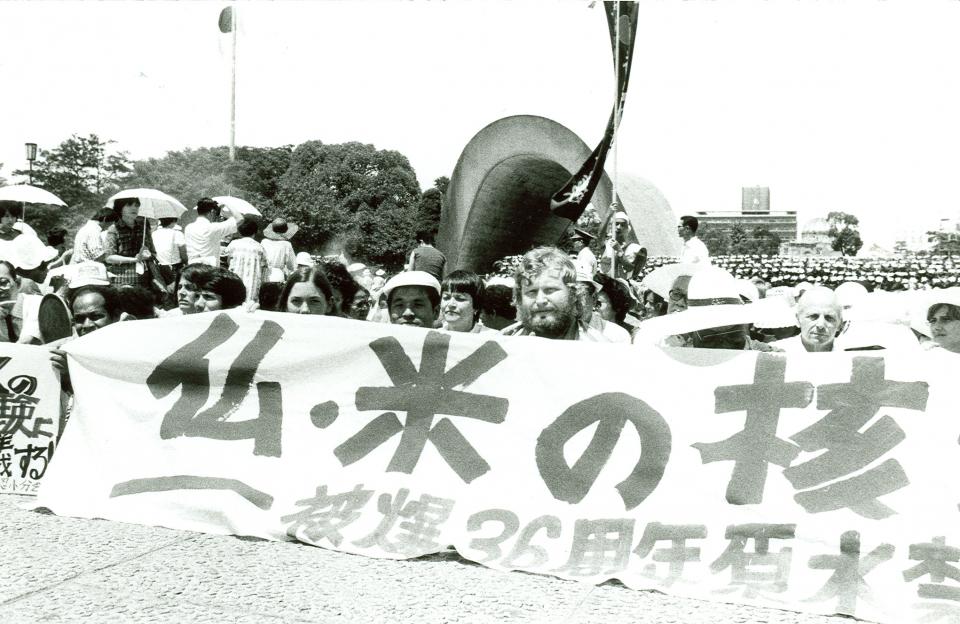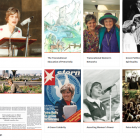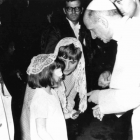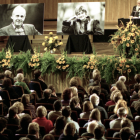5. Asserting Women’s Power: Petra Kelly and Women’s Transnational Antinuclear Weapons and Peace Activism in the 1980s
Petra Kelly’s work protesting against nuclear weapons and for peace in the 1980s offers important insight into a movement that spanned the Cold War Eastern and Western blocs. Kelly was a prominent member of a diverse array of transnational women peace activists in the 1980s. These women came from different national contexts, including, but not limited to, West Germany, the United Kingdom, the United States, and the Soviet Union. They regularly connected with one another across national and Cold War boundaries and worked together to advocate publicly for change in their countries’ military, foreign, and domestic policies. Scholars in recent years have recognized the importance of Petra Kelly’s transnational activism in relation to Green politics in particular. However, a focus on her transnational antinuclear-weapons and peace work shows that she had an impact beyond the West German Die Grünen, connected peace activists across Cold War Eastern and Western borders, and challenged traditional methods of international relations throughout the 1980s.
As a founding member and leader of Die Grünen, Petra Kelly held a prominent role in the women’s transnational peace and antinuclear-weapons movements. Born in West Germany and educated in the United States, Kelly was primed for both understanding the impact that transnational, grassroots peace activism could have and for carrying out that work. These experiences created a foundation for Kelly’s peace work in the 1980s by teaching her the importance of grassroots activism, helping her build political networks internationally, and fostering her belief in “popular politics.” The antinuclear weapons popular political movement was comprised of people located across the globe working and thinking beyond national borders. Kelly’s personal charisma was an important asset in her engaging with audiences across Europe and the United States and drawing people to her cause. She was a vocal leader of this transnational peace and antinuclear-weapons movement in the 1980s.

Figure 1. Petra Kelly speaking at an antinuclear demonstration in London in 1980 on the first anniversary of the partial meltdown of the Three Mile Island nuclear power plant.
Figure 1. Petra Kelly speaking at an antinuclear demonstration in London in 1980 on the first anniversary of the partial meltdown of the Three Mile Island nuclear power plant.
Unknown photographer, 1980. © Archiv Grünes Gedächtnis (signature: FO-01559-04). Used by permission.
The copyright holder reserves, or holds for their own use, all the rights provided by copyright law, such as distribution, performance, and creation of derivative works.
Kelly used her platform as a peace activist and politician to advocate for change in traditional politics and at the grassroots level. From 1983 to 1990, her role in the Bundestag as a member of Die Grünen meant that she held a position that offered her a prominent platform. Kelly utilized this position to advocate her positions in West Germany and beyond, regularly traveling across the globe as a representative of Die Grünen to meet with other activists. She was also an innovative thinker, regularly introducing new ideas and initiatives to push the antinuclear-weapons movement forward and connecting antinuclear activism to broader topics, like women’s issues. As an outspoken leader of the women’s peace movement, Kelly exemplified many of the tactics and goals of other women peace activists as she pursued a grassroots, feminist approach to mobilizing everyday citizens to action. At the same time as Kelly made demands of governments across the globe to change their nuclear weapons policies, she and other women worked together to change from the bottom up how people understood peace.
Kelly’s transnational peace work was informed by and connected to the rest of her political life, namely through an interest in promoting a new way of conducting diplomacy and advocating an ecofeminist political framework in foreign relations. Much like her work as a founder and member of Die Grünen, Kelly’s work as a transnational peace and antinuclear-weapons activist was focused on disrupting traditional methods of governance through grassroots mobilization of a Green way of thinking. In 1982, she received the Right Livelihood Award, also known as the Alternative Nobel Peace Prize. Accepting the award, she argued that everyday citizens needed to take initiative and conduct foreign policy with one another: “if the governments do not take these first steps [to disarm], we shall take these first steps for them! We must work towards a disarmament race.” This new style of doing international relations often came in the form of rallies, public seminars, or small group meetings about specific issues, a more democratized and publicly available way of conducting international diplomacy than elite diplomatic summits.

Figure 2. Petra Kelly and Gert Bastian (right) sit with fellow protestors against atomic and nuclear bombs in Hiroshima, Japan, August 1981. Petra gave speeches in Tokyo and Hiroshima and coordinated with Japanese activists on this trip.
Figure 2. Petra Kelly and Gert Bastian (right) sit with fellow protestors against atomic and nuclear bombs in Hiroshima, Japan, August 1981. Petra gave speeches in Tokyo and Hiroshima and coordinated with Japanese activists on this trip.
Unknown photographer, 1981. © Archiv Grünes Gedächtnis (signature: FO-01984-02). Used by permission.
The copyright holder reserves, or holds for their own use, all the rights provided by copyright law, such as distribution, performance, and creation of derivative works.
Along with her work in the West German Bundestag, Kelly’s political activism reached across national borders as she physically traveled to different countries and kept up robust letter-writing efforts discussing antinuclear-weapons politics and peace politics with everyday citizens, activists, and politicians alike. For example, a visit Kelly took to Japan in the summer of 1981, during which she met with Japanese antinuclear-weapons activists and survivors of the nuclear attacks on Hiroshima and Nagasaki, shows how women activists like Kelly both worked and thought globally. Kelly gave a speech in Tokyo and Hiroshima titled “Euroshima, Mon Futur?” (Euroshima, My Future?) in which she discussed the myriad efforts that European and US-based activists were taking to do “all we can to avoid a ‘Euroshima’.” “Euroshima” invoked the horrors of nuclear war found in Hiroshima as a rallying cry against a nuclear weapons buildup in Europe in the early 1980s. Protesters were particularly energized by the US Pershing II and cruise missiles slated for deployment across Europe in 1983–1984 as a NATO response to the Soviet SS-20 missiles first deployed in 1976. Combining Europe and Hiroshima created a link between Europe and Japan that both invoked fear of nuclear destruction in Europe and sympathy for victims in Japan. Concerns about these missiles and the wider threat of nuclear war catalyzed hundreds of thousands to protest across the globe in the early 1980s. These included numerous events where Kelly spoke about the need to continue protesting against nuclear weapons, including to 130,000 people in Hamburg, West Germany, in June 1981 and 15,000 to 20,000 protesters in Philadelphia in the United States in October 1983.

Figure 3. Petra Kelly, alongside other peace activists like Eva Quistorp, Gert Bastian, and Rudolf Bahro, holds up a banner saying “For a nuclear-weapons-free Europe” in Bonn, 1980 or 1981.
Figure 3. Petra Kelly, alongside other peace activists like Eva Quistorp, Gert Bastian, and Rudolf Bahro, holds up a banner saying “For a nuclear-weapons-free Europe” in Bonn, 1980 or 1981.
Unknown photographer, 1980 or 1981. © Archiv Grünes Gedächtnis (signature: FO-0726). Used by permission.
The copyright holder reserves, or holds for their own use, all the rights provided by copyright law, such as distribution, performance, and creation of derivative works.
Many accounts of antinuclear-weapons activism in the 1980s end with the deployment of the cruise and Pershing II missiles in the winter of 1983–1984. Studying Kelly and other women activists shows that their transnational peace and antinuclear-weapons work continued later in the decade and engaged both grassroots activist audiences and elite political figures, consistently arguing for a redefinition of international relations and of peace. In a speech at the University of California, Berkeley, campus in October 1984, Kelly argued that antinuclear-weapons and peace politics in international politics was “about abolishing power as we know it and redefining power as something common to all . . . Peace means more than just an absence of war.” She explored this line of thinking further in a series of letters to the East German Socialist Unity Party General Secretary Erich Honecker in 1984, written as a representative of the West German Bundestag. She pushed him to consider how the “‘Peace movement’ not only has to do with nuclear or chemical disarmament, but also with standing up for the democratic rights of the individual.” She reiterated the need for a new idea of peace and freedom when speaking at a European Nuclear Disarmament rally in Amsterdam, the Netherlands, in July 1985. Activists in Western Europe could not only protest against nuclear weapons but also needed to support independent politicians in the Soviet bloc like Václav Havel and Charter 77 in Czechoslovakia, Adam Michnik and Solidarność in Poland, and Katja Havemann and Frauen für den Frieden (Women for peace) in East Germany: “Peace is not just an absence of . . . Pershing II and SS-20s . . . [but also] a positive external and internal condition where people are free.” Her remarks also engaged in feminist, gendered critiques of violence, asserting that to be successful, peace activists needed to “challenge conventional gender roles and . . . break the circle of violence.”
Kelly and other women activists’ work had a significant impact at the grassroots level, mobilizing hundreds of thousands for peace throughout the 1980s, long after the deployment of the Pershing II and cruise missiles. This work included local educational outreach, petition, and letter-writing campaigns, and international citizen diplomatic exchanges, among other actions. Top political leaders recognized the importance of the work of women antinuclear-weapons activists. At the 1987 World Congress of Women held in Moscow, for example, the Soviet Union Communist Party General Secretary Mikhail Gorbachev gave an opening address where he asserted that “the international women’s movement has markedly reinforced the potential of peace and goodwill. It has forced people to listen to it. It is a real factor in politics.”

Figure 4. Petra Kelly (second from left) at a 1981 peace rally against nuclear weapons near a NATO air base in Geilenkirchen. Pictured, from left to right: Kunigunde Birle (Petra Kelly’s grandmother), Petra Kelly, Die Grünen members Christa Nickels and Gerda Degen.
Figure 4. Petra Kelly (second from left) at a 1981 peace rally against nuclear weapons near a NATO air base in Geilenkirchen. Pictured, from left to right: Kunigunde Birle (Petra Kelly’s grandmother), Petra Kelly, Die Grünen members Christa Nickels and Gerda Degen.
Unknown photographer, 1981. © Archiv Grünes Gedächtnis (signature: FO-01313-01). Used by permission.
The copyright holder reserves, or holds for their own use, all the rights provided by copyright law, such as distribution, performance, and creation of derivative works.
Kelly serves as an important example of a broader phenomenon of women activists in the 1980s who campaigned across the Cold War Eastern and Western blocs to protest against nuclear weapons development and deployment and for peace. Like Petra Kelly, many other women and women’s groups engaged one another in transnational peace activism and diplomacy throughout the decade as they fought for further women’s inclusion in international politics and for a more peaceful future for themselves and their children. These included but were not limited to the US-based Women’s International League for Peace and Freedom and Women for Meaningful Summits groups led by women like Margarita Papandreou and Edith Ballantyne, the Soviet-state-backed Soviet Women’s Committee led by Valentina Tereshkova, and activists like French Green activist Solange Fernex or US activist Cora Weiss, who both worked with numerous groups. Their contributions to the rapidly changing international political scene during the 1980s help us better understand the diverse range of ideas and opinions about Cold War international politics. They advocated for a new way of doing international politics that redefined peace as an active condition, not just the absence of nuclear weapons or Cold War tensions. Their ideas demanded attention and shaped the political environment in which elite politicians like Gorbachev and US President Ronald Reagan made decisions. Peace was made a political issue in which people across the Cold War Eastern and Western blocs believed.










